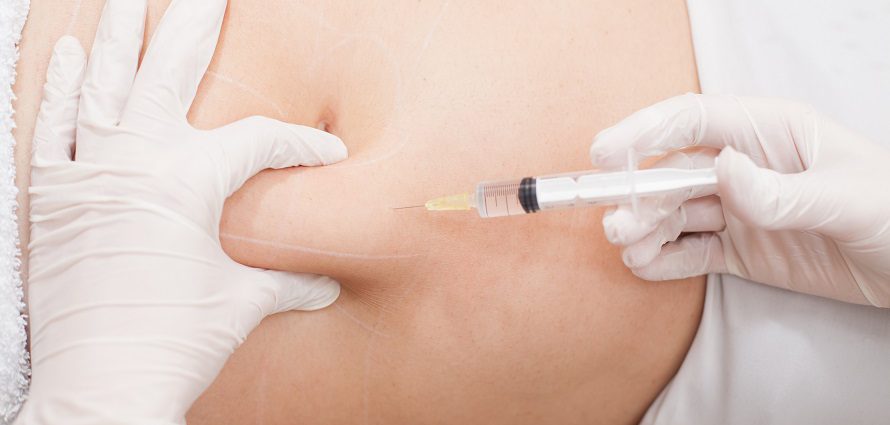Lipodissolve – Is It Safe?

Reviewed by Peter Fodor, MD, FACS
Here you’ll find information on:
- What Is Lipodissolve?
- Lipodissolve: Current Status
- Questions to Ask Your Surgeon About Lipodissolve
- Lipodissolve Costs
Perhaps you have heard of lipodissolve. There is much buzz and some controversy surrounding this experimental “fat-melting” technology. Often touted as a non-surgical alternative to liposuction, lipodissolve is also known as mesotherapy, lipolysis, injection lipolysis or Lipostabil.
Here’s what we know now about lipodissolve and what we still need to learn.
What Is Lipodissolve?
Lipodissolve involves a series of medicated injections that may melt away small, localized areas of fat, but not large areas. While the ingredients used in lipodissolve may vary depending on the doctor and the area being treated, the chemical cocktail typically includes phosphatidylcholine/deoxycholate (PC/DC), multivitamins, alpha lipid acid, enzymes and plant extracts. Phosphatidylcholine is a soybean extract, and deoxycholate is a bile derivative. Phosphatidylcholine is approved by the Food and Drug Administration (FDA) to break down blood fats that may increase risk for heart disease, but it is not approved for injection or any other purpose.
Some doctors may also add nonsteroidal anti-inflammatory drugs, antibiotics and hormones to the mixture. There is no standard ingredient list. Many of the individual ingredients are not FDA-approved on their own, let alone as part of a chemical cocktail. These cocktails are typically prepared in compounding pharmacies that specialize in customizing formulations of drugs based on a doctor’s orders.
During the lipodissolve procedure, your doctor injects the cocktail into the fat layers and connective tissue. The injection is relatively painless, with no need for anesthesia. The medication produces a chemical reaction to dissolve localized areas of fat. Typically, benefits are seen within three weeks of the treatment. Several treatments, four to six weeks apart, are often required to produce the maximum result. There is no downtime after lipodissolve.
Several theories exist to explain where the fat goes. Some researchers suggest it migrates to other areas of the body with fat cells, including the arteries. The amount of fat is so minuscule, however, that it likely causes no problems. Others believe the melted fat is naturally excreted from the body.
Lipodissolve: Current Status
Lipodissolve is currently considered an experimental treatment. It is not approved by the FDA. Clinical studies in the United States that look at the safety and efficacy of lipodissolve are under way. Some medical practices that offer lipodissolve are also working toward establishing the right protocols for the procedure.
In addition, the American Society for Aesthetic Plastic Surgery recently announced the preliminary results of its own small study of mesotherapy. Seven participants were injected with a standardized PC/DC cocktail in one half of their abdomen during up to four sessions that were spaced eight weeks apart. They were allowed to request treatment in the other side of their abdomen after the initial results were analyzed.
Study investigators used magnetic resonance imaging to measure any changes in fat thickness. Lipodissolve treatments banished one centimeter of fat on the treated side. Six of seven study participants said they saw a visible difference and opted to treat the other side of their abdomen. Lipodissolve side effects included swelling, redness, bruising and some pain, but there were no serious side effects seen in this study. The next step is to follow participants for longer periods of time, and possibly study this treatment among larger groups of people.
Not everyone is considered a candidate for Lipodissolve. Mesotherapy should not be used in pregnant women, nursing mothers, obese individuals or people with diabetes, autoimmune diseases, vascular (blood vessel) complications or infections of any kind.
Questions to Ask Your Surgeon About Lipodissolve
Some plastic surgeons and dermatologists have experience with lipodissolve through clinical trial participation. Before you consider lipodissolve:
- Review the doctor’s credentials, education, training, type of certification held and the number of times that he or she has performed the treatment.
- Ask about the ingredients in the medication and the amount to be used in your lipodissolve procedure.
- Ask the doctor to estimate the number of treatments required to achieve and maintain the benefit.
If you are considering lipodissolve, your next step is a consultation with a board-certified plastic surgeon or dermatologist who is familiar with lipodissolve and alternative spot reduction treatments such as Zeltiq CoolSculpting or Zerona. Discuss your concerns and goals with the doctor so he or she can better determine which treatment or treatments are right for you. If your surgeon suggests an alternative treatment such as liposuction, be sure to ask about all aspects of the procedure, including liposuction risks and liposuction recovery. Start your search for a local lipodissolve doctor now.
Lipodissolve Costs
Costs for lipodissolve may range from $375 to $1,500 per treatment. Up to six treatments may be needed.
The extent of treatment also makes a cost difference. For example, fat removal under the chin will cost less than removal of “saddlebags.” The amount of medication required also depends on the area to be treated.
About the Reviewer of This Article
Peter Bela Fodor, MD, FACS, of Los Angeles, is an internationally recognized leader in the field of aesthetic plastic surgery and is highly respected by the profession as a surgeon, teacher and author. Dr. Fodor is associate clinical professor of plastic surgery at UCLA Medical Center. He lectures and performs live surgical demonstrations nationally and internationally.
After graduating from the University of Wisconsin Medical School, Dr. Peter Fodor completed his general surgery residency at New York’s Columbia University and his plastic surgery residency at St. Luke’s – Roosevelt Hospital. Dr. Fodor maintains hospital staff privileges at UCLA Medical Center, Century City Doctors Hospital and Olympia Hospital, all in Los Angeles, as well as at St. John’s Hospital in Santa Monica, Calif. He is board-certified by both the American Board of Surgery and the American Board of Plastic Surgery.



